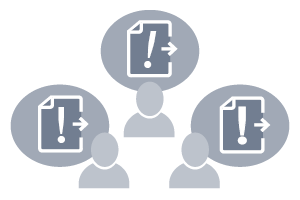
A word cloud exercise can be used to gather individual responses from participants and then reflecting the entire group’s responses back to them, as a visual text representation (i.e. collection or visual ‘cloud’ of words). It can be used to gather and summarise information, to invite opinions anonymously, or to show different views on a specific topic. It is often used to socialise a group (i.e. as an ice-breaking activity) but it can also be used to actively engage the participants during the rest of the session, as it will provide them the opportunity to first (anonymously and individually) share their thoughts on a topic, and then to also get a sense of the rest of the group’s perceptions.
OVERVIEW
Before the workshop, the facilitator will first create a link to a new, online word cloud activity by using a word cloud generator. (See: Background/sources for suggestions on free tools). During the workshop, the facilitator will pose a question to the participants, and they will have the opportunity to submit a text-based response, by clicking on the unique the link. (Note: The participants will each need access to an Internet-connected smart device, e.g. laptop or smart phone, to do this). After they have all submitted their responses, they will be able to view the online word cloud that was automatically created by the relevant software. If any word were repeated across the response, these will display larger, or in a bolder/brighter colour format than the other words.
WORKSHOP PHASE
NUMBER OF PARTICIPANTS
Any number of participants
No minimum or maximum, although word clouds are visually richer with medium to large groups.
TIME |
MODE OF DELIVERY
Minimum 5 minutes | F2F & Online
TOOLS/MATERIALS
- The facilitator and each participant need access to the Internet, as well as a smart device (e.g. personal laptop or smart phone).
- An online word cloud generator (See a list of free options in the ‘Background/Sources’ section).
PREPARATION
- The facilitator should think about a question to pose to the participants. For an ice-breaking activity, the question should reveal something about the participants, e.g. asking them where they are logging on from (if it is an online workshop), where they are born/where the live, what their professional title is, or why they signed up for the workshop. If the word cloud will be used later in the workshop, the question could be more content-focused, e.g. asking them to share their thoughts on a specific topic, or to share what they have learned so far.
- Using a free word cloud tool, the facilitator should create a new word cloud exercise/template, and save the link. The link should be ready to share electronically during the session (e.g. copied and pasted in a webinar chat) or to be displayed via a QR code that participants can scan with their phones. The link sharing options will depend on the word cloud tool.

Step 1
During the workshop, the exercise starts by the facilitator explaining the purpose of the exercise (e.g. for participants to get to know one another better, or to prompt them to think about a topic).
The facilitator explains that a link will be shared, and that the participants will be asked to respond to a question, electronically. They should be informed that their responses will remain anonymous, but that a visual summary of all the responses will be displayed back to them at the end of the exercise.

Step 2
The facilitator shares the link – ideally as a hyperlink that is posted in the webinar chat - and instruct participants to click on it, and to respond within a certain timeframe (i.e. within 3-4 minutes).

Step 3
The facilitator alerts the participants when they have 1 more minute to complete their responses. Then, the facilitator shares the completed word cloud that was generated by the online tool. (Most tools allow the option for the person that created the exercise to share a link to the results with the respondents, or they can share their screen displaying the results).

Step 4
The facilitator can comment on the word/phrases that have been repeated the most, and also highlight other ones that may be interesting or unusual. The participants can also comment on what they find surprising or interesting about their peers’ responses.
- The participants should be able to answer the question in a few key words or in a single phrase. However, ‘yes/no’ questions should be avoided.
- If a word cloud exercise will be used in a face-to-face workshop, the facilitator should check beforehand that all participants have access to their own smart device and that they can connect to the venue Wi-Fi. They should also be able to access the electronic link if shared with them, or have a QR scanner on their phones.
- Most online word cloud tools provide easy, step-by-step guidelines on how to create and share a word cloud. If using a new software/tool the first time, the facilitator should test it before the session (e.g. by creating a demo exercise and sharing the link with their co-facilitator).
- A completed word cloud can often be downloaded in a PDF format, or the facilitator can take a screenshot of it, and share it with participants after the workshop as part of their resource pack.
It is unclear who invented the first word cloud tool, but it has become more popular since the early 2000s.
This exercise summary draws from the practical experience of the database contributors, as well as the following resources retrieved on 3 June 2022:
- Paige Puntillo (2022). 10 Engaging Types Of Word Cloud Activities To Excite Your Classroom. https://www.classpoint.io/engaging-word-cloud-activities/
- Dolly Menke (2016). Word Cloud Activities: Engaging Learners In The Online Classroom. https://dl.sps.northwestern.edu/blog/2016/01/word-cloud-activities-engaging-learners-in-the-online-classroom/
Lists of (free, online) word cloud generating tools:
Word clouds are also used to summarise an existing piece of text. Before the workshop, the facilitator can copy the text-based content from a pre-workshop reading, the workshop framework/outline, or pre-workshop survey responses and paste it in an online world cloud generator, to create a visual summary of the content. This can be shown during the workshop to start a discussion about the content and the key themes that are visually displayed.
« Methods

